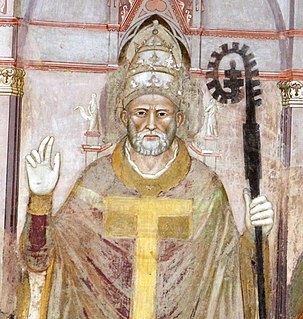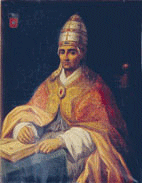
Pope Clement VI, born Pierre Roger, was head of the Catholic Church from 7 May 1342 to his death in 1352. He was the fourth Avignon pope. Clement reigned during the first visitation of the Black Death (1348–1350), during which he granted remission of sins to all who died of the plague.

Pope Innocent VI, born Étienne Aubert, was head of the Catholic Church and ruler of the Papal States from 18 December 1352 to his death in 1362. He was the fifth Avignon pope and the only one with the pontifical name of "Innocent".

Pope John XXII, born Jacques Duèze, was head of the Catholic Church from 7 August 1316 to his death in 1334.

Hélie de Talleyrand-Périgord was a French Cardinal, from one of the most aristocratic families in Périgord, south-west France. Hélie was born at Périgueux, third son of Elias VII, Count of Périgord, and Brunissende of Foix, daughter of Roger Bernard III, comte de Foix. His elder brothers were Archambaud (IV), who inherited the County, and Roger-Bernard ; his younger brother was Fortanier, and his sisters were Agnes, Jeanne, Marguerite, and Rosemburge. As a third son Hélie was destined for an ecclesiastical career. His brother, Roger Bernard, too, had an ecclesiastical career, becoming Canon of Lyon. But then, the eldest son died, and Roger-Bernard became the Count of Périgord. Hélie became a major figure in the Avignon papacy, and also a diplomat engaged in the negotiations of the Hundred Years' War, having friendships in both English and French royal families. In his last months he had been appointed Papal Legate for a crusade against the Turks.

The Diocese of Dax or Acqs was a Roman Catholic ecclesiastical territory in Gascony in south-west France. According to tradition it was established in the 5th century. It was suppressed after the French Revolution, by the Concordat of 1801 between First Consul Napoleon Bonaparte and Pope Pius VII. Its territory now belongs to the Diocese of Aire and Diocese of Bayonne.

The 1342 papal conclave – the papal conclave convened after the death of Pope Benedict XII, it elected Cardinal Pierre Roger, who became the fourth Pope of the period of Avignon Papacy under the name Clement VI.

Pierre Desprès was a French Cardinal during the period of Avignon Papacy. He was son of Raymond II Desprès, seigneur of Montpezat, and Aspasie de Montaigut, the heiress of Bertrand, seigneur de Montaigut. He had a brother, Raymond, who was ennobled in 1325. Pesserat points out that Montpezat was an important town, being the seat of the Archdeacon of Montpezat in the diocese of Cahors, who was also Sacristan of the Cathedral. Not at all coincidentally, Pope John XXII was a native of Cahors, and his father had been Sieur de Saint-Félix en Quercy. With his expertise in the law as a teacher and practitioner, and with his experience as a judge in the Roman Curia, Pierre Desprès was appointed Vice-Chancellor of the Church by John XXII, where he served from 1325 to 1361. He was thus head of the Papal Secretariat, in charge of the drafting of papal bulls and letters, and a principal papal advisor. The post was also one of the most lucrative in the Roman Curia, since a fee was charged for every document and the Vice-Chancellor received a share of every fee.

The 1370 papal conclave, held after the death of Pope Urban V, elected as his successor cardinal Pierre Roger de Beaufort, who under the name Gregory XI became seventh and the last pope of the period of Avignon Papacy.

The Musée du Petit Palais is a museum and art gallery in Avignon, southern France. It opened in 1976 and has an exceptional collection of Renaissance paintings of the Avignon school as well as from Italy, which reunites many "primitives" from the collection of Giampietro Campana. It is housed in a 14th-century building at the north side of the square overlooked by the Palais des Papes.

Arnaud de Pellegrue was a cardinal-nephew of Pope Clement V, the first pope of the Avignon Papacy.

The 1314–16 papal conclave, held in the apostolic palace of Carpentras and then the Dominican house in Lyon, was one of the longest conclaves in the history of the Roman Catholic Church and the first conclave of the Avignon Papacy. The length of the conclave was due to the division of the cardinals into three factions: Italian, Gascon, and French/Provençal.
Arnaud de Villemur O.Can.S.A. was a cardinal of the Catholic Church. He was bishop of Pamiers, France.
Napoleone Orsini was a Roman Cardinal. His ecclesiastical career lasted 57 years, 54 of them as a cardinal, and included six conclaves.

The 1334 papal conclave elected Jacques Fournier as Pope Benedict XII to succeed Pope John XXII.
Pope John XXII (1316–1334) created 28 new cardinals in six consistories:

Imbert du Puy was a French Cardinal of the fourteenth century. He was a nephew of Pope John XXII.

Bertrand de Déaulx was a French bishop, diplomat and Cardinal. He was born, perhaps around 1290, in Castrum de Blandiaco in the diocese of Uzès; or in Déaulx. He died in Avignon in 1355. Trained as a lawyer and teacher of law, he practiced in the papal courts, and became an arbitrator and diplomat for the Papacy. He had several assignments in Italy and one in Catalonia. He was responsible for the reorganization of the University of Montpellier and the granting of revised charters.

The Collégiale Notre-Dame is a Gothic church in Villeneuve-lès-Avignon, Gard, Occitanie, France.

Jacques de Via was a French cardinal in the Roman Catholic Church. His brother Arnaud was also a cardinal.
Hugues Géraud was a 14th-century Roman Catholic bishop, serving as bishop of Cahors from 1313 until his dismissal in 1317 for attempting to murder pope John XXII by poison and witchcraft, for which he was burned at the stake.














